Als strategischer Partner für die Luft- und Raumfahrtindustrie unterstützt ARTS mit mehr als 500 technischen und kaufmännischen Experten Unternehmen dabei, ihre Geschäftsprozesse für Produktion und Personal zu optimieren. Das Thema Business Intelligence (oder kurz "BI") ist bei ARTS kein Schlagwort, sondern gelebte Praxis. Mithilfe einer multidimensionalen Datenbank und eines innovativen BI-Tools ("Jedox") werden die Vorsysteme (ERP-System Odoo, Buchhaltungssoftware DATEV etc.) vereinheitlicht. In diesem Blog erfahren Sie, welchen Herausforderungen die Branche gegenüber steht, welche Vorteile die Einführung einer Business Intelligence Software bietet und mithilfe welcher Implementierungsvorgehensweise Sie Ihren Projekterfolg maximieren.
ARTS unterstützt europaweit unter anderem die Luft- und Raumfahrtindustrie mit Expertise: mit Menschen und ihrem Wissen oder schlüsselfertigen Lösungen. Mit seiner Expertise für die Branche verhilft ARTS seinen Kunden zu neuen Ideen sowie zusätzlichen Kapazitäten, damit diese Engpässe überbrücken und sich auf ihr Kerngeschäft konzentrieren können. Unter der Dachmarke ARTS vereinen sich drei Servicefelder Experts, Processes und Solutions. Jedes Servicefeld wird innerhalb der ARTS Gruppe durch ein eigenständiges ARTS-Unternehmen verantwortet.
Als kompetenter Partner für maßgeschneiderte Systeme agiert die manaTec GmbH als präferierter Dienstleister bei der Einführung der Business Intelligence Lösung bei ARTS. Neben dem IT-Consulting, IT-Support und ERP-Entwicklung, zählt das BI-Consulting zu den Kernkompetenzen der manaTec GmbH. In der nachfolgenden Abbildung sind die verschiedenen Leistungsbereiche der manaTec GmbH sowie ein Auszug aus dem jeweiligen Leistungsportfolio dargestellt.
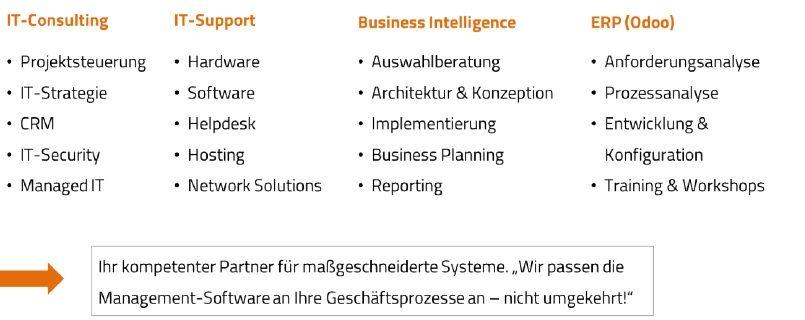
Mangelnde Flexibilität durch starre Informationssysteme
Veränderte Marktbedingungen, erhöhter Kostendruck und der immer stärker werdende Kampf um Kunden und Marktanteile sorgen inzwischen auch im Mittelstand für eine steigende Bedeutung von Ad-hoc Analysen und Echtzeitauswertungen von Unternehmenskennzahlen. Positiv beeinflusst durch steigenden Wettbewerb unter den Anbietern entsprechender Tools, setzen vermehrt auch mittelständische Unternehmen Business Intelligence Software ein.
Dabei kann Business Intelligence noch viel mehr: erst die Aggregation mehrschichtiger Datenauswertungen unterstützt die Unternehmenssteuerung auf strategischer Ebene. Die Aufbereitung und Quantifizierung der Daten in sogenannten Key Performance Indikatoren ermöglicht die Messung der Erfolge und das Ableiten zielgerichteter Maßnahmen. Auf diesem Weg können sich Data Analytics Methoden in der Unternehmenspraxis als entscheidender Erfolgsfaktor entwickeln. Die nachfolgende Abbildung verdeutlicht die Auswirkungen starrer und inflexibler Vorsysteme.

Starre Vorsysteme schränken Flexibilität ein
- Inkonsistente Datenhaltung durch Insellösungen
- Zeitintensive Ad-hoc Auswertungen
- Langsame Reaktionsfähigkeit bei Managemententscheidungen
- Fehlende Verknüpfung von Finanz- und ERP-Daten
- Excelbasierte Unternehmensplanung stößt an seine Grenzen
- Finanzielle Konsolidierung mit bestehenden Tools nicht möglich
Die Ausgangslage ist in der Praxis oft die Gleiche: speziell im Mittelstand dienen häufig Excel-Listen als Entscheidungsgrundlage. In der Regel stammen die Daten aus verschiedenen Vorsystemen und werden händisch angepasst. Genau hier liegt eine der größten Schwachstellen der oft nur durch den vergleichsweise geringen Einsatz von modernen IT-Lösungen geprägten mittelständischen Systemlandschaften: neben dem Risiko der inkonsistenten Datenhaltung sind spontane Ad-hoc Auswertungen aufgrund starrer Informationssysteme nicht oder nur schwer möglich. Insbesondere das spontane Anpassen von Berichten und deren Anreicherung der Informationsdichte sind sehr zeitintensiv. Daraus resultieren langwierige und fehlerbehaftete Controllingprozesse, verzögerte Entscheidungen und schlussendlich eine erschwerte Unternehmenssteuerung.
Data Warehouse eröffnet völlig neue Perspektiven
Im Fall von ARTS potenzierten sich die dargestellten Probleme aufgrund einer gesellschaftsrechtlichen Umstrukturierung und dem Aufbau einer Konzernstruktur in Verbindung mit der innerbetrieblichen Leistungsverrechnung. Insbesondere eine parallel entstandene Systemlandschaft mit verschiedenen Vorsystemen (ERP-System, Buchhaltungssoftware, Dokumentenmanagement) führte dazu, dass die Datengenerierung für abteilungsübergreifende Auswertungen oft ineffizient war.
Daraus resultierend wurden zeitkritische Entscheidungen zur Unternehmenssteuerung nur begrenzt rational durch Fakten untermauert getroffen. Die fehlende Verknüpfung zwischen Daten aus dem ERP-System und der Finanzperspektive aus der Buchhaltungssoftware verdeutlicht die Datenhaltung in isolierten Inseln. Darüber hinaus wurde die Komplexität der Unternehmensplanung infolge der gesellschaftsrechtlichen Umstrukturierung auf eine neue Ebene gehoben: während die bisherige Excel-basierte Planungslösung bereits bei einer einzigen Gesellschaft an ihre Grenzen stieß, galt es nun eine integrierte Planungslösung über alle Gesellschaften der ARTS Gruppe zu entwickeln. Ebenso war es nicht möglich, einen bereinigten Jahresabschluss der ARTS Gruppe darzustellen (Konzernkonsolidierung).
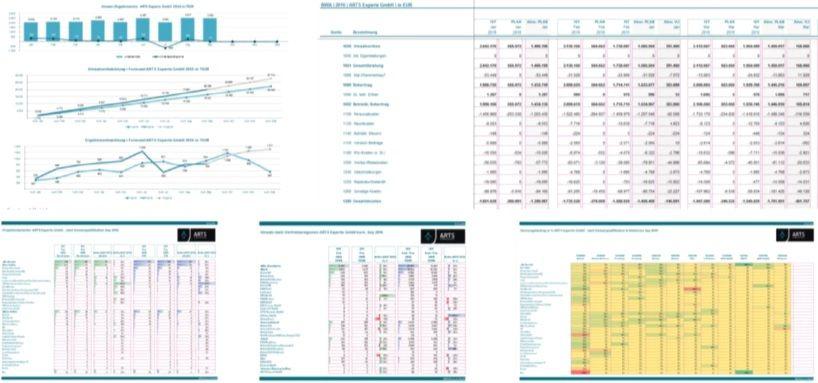
Die Einführung einer Business Intelligence Software bot dadurch mehrere Vorteile. Die schnelle Analyse und Auswertung mehrschichtiger Daten führt zu einer verbesserten Reaktionsfähigkeit auf Managementebene. Daten nach verschiedenen Dimensionen auswerten zu können, bietet zunächst die Möglichkeit einer adressatengerechten Gestaltung der Berichte. Darüber hinaus sorgt die Möglichkeit, innerhalb kürzester Zeit Ad-hoc Berichte erstellen zu können, für eine verbesserte Reaktionsfähigkeit auf veränderte Rahmenbedingungen.
Der entscheidende Vorteil der Lösung liegt jedoch in der Integration der bestehenden Systemlandschaft und der Vernetzung der verschiedenen Vorsysteme: durch die Verdichtung der Daten werden völlig neue Perspektiven auf die angebundene Datenbasis ermöglicht. Egal ob Margen- oder Deckungsbeitragsbetrachtung, oder HR-Kennzahlen - die Möglichkeit, Daten ähnlich der Funktionsweise eines Rubik’s Cube aus verschiedenen Perspektiven zu betrachten (Slicing & Dicing), eröffnet eine ganzheitliche Rundumsicht auf das eigene Unternehmen. Durch die Verdichtung der Daten aus verschiedenen Vorsystemen kann die Entscheidungsqualität im Management immens gesteigert werden. Viel mehr noch: durch eine zentrale Datenbasis entwickelt sich das BI-System zur "single source of truth".
Neben dem Reporting der Ist-Daten bietet eine Business Intelligence Lösung auch den Vorteil, durch Hinzufügen eines neuen Datentyps, die Unternehmensplanung abzubilden.
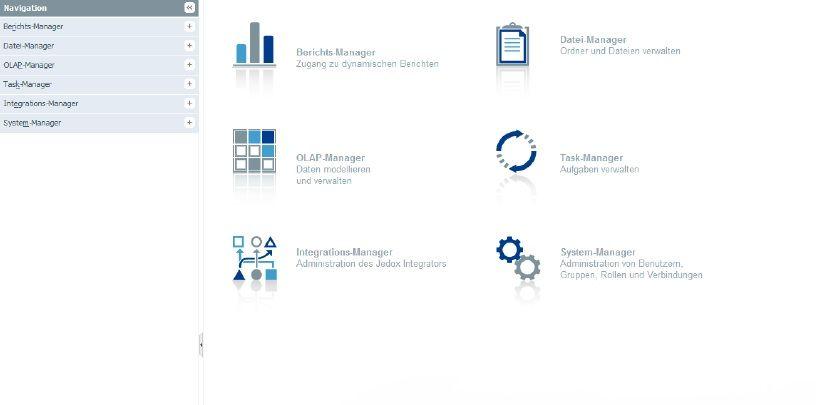
Die umgesetzte Lösung mithilfe von Web-Templates ermöglicht einen effizienten Planungsprozess und die Einbindung dezentraler Vertriebseinheiten ohne den umständlichen Austausch von Excel-Sheets. Das Arbeiten mit Web-Templates bietet dabei mehrere Vorteile. Durch den Einsatz von dynamischen Bereichen bleibt das gesamte Template skalierbar, ohne dass eine manuelle Anpassung notwendig ist. Gleichzeitig lässt sich mithilfe eines Rollen- und Benutzerkonzeptes ein effizienter Workflow innerhalb des Planungsprozesses abbilden und so dessen Effizienz steigern.
Mithilfe des Einsatzes von Web-Berichten kann auch das Reporting aufgebohrt werden. So können beispielsweise vorgefertigte Berichte mit Comboboxen versehen werden. Hierüber besteht die Möglichkeit, dass der Fachanwender eigenständig und unabhängig vom Power-User in der Lage ist, Analysen und Reports zu erstellen ("Self-Service Business Intelligence"). Im Anschluss besteht die Möglichkeit, durch einen vorher festgelegten Workflow, Berichte automatisiert zu versenden.
Konzeption als Kritischer Erfolgsfaktor der Implementierung
Die Implementierung eines Business Intelligence Tools setzt zunächst die Erstellung einer Strategie bzw. eines Konzeptes voraus. Dabei ist festzulegen, in welchem Umfang die Software innerhalb des Unternehmens ausgerollt werden soll (Reporting, Konsolidierung, Planung). Die möglichst detaillierte Festlegung der Anforderungen vor der Einführung (idealerweise in Form eines Lastenheftes) ist die wichtigste Voraussetzung für die erfolgreiche Implementierung.
Tiefgreifende Änderungen in der definierten Struktur des Systems lassen sich nur mit großem Aufwand über den gesamten Datenbestand umsetzen (Problematik der "slowly changing dimensions"). In diesem Zusammenhang ist bereits in der Auswahlphase des BI-Tools zu prüfen, ob eventuelle Einschränkungen vorliegen. ARTS hat sich für die BI-Lösung der Jedox AG entschieden. Ein Vorteil dieser Lösung ist die Excel-Integration des Front-End-Bereiches, wodurch bereits vorhandenes Know-How zum Erstellen von Reports ohne umfangreiche IT-Einbindung genutzt werden kann.
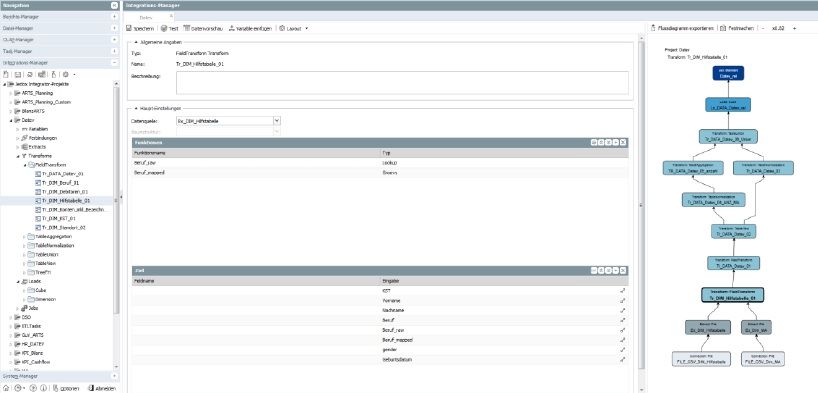
Die im Data Warehouse gespeicherten Daten werden über ETL-Strecken zunächst an das System angebunden (Extract), in mehreren Transformationsstufen umgewandelt (Transform) und schlussendlich in die Datenbank geladen (Load). Die geladenen Daten werden wiederum in Data Cubes zusammengeführt. Eine der größten Herausforderungen bei der Implementierung stellte das effiziente Stammdaten-Management innerhalb des Systems dar.
Um eine hohe Datenqualität gewährleisten zu können, wurden spezielle ETL-Strecken angelegt, die bereits in einem ersten Schritt prüfen, ob entsprechende Stammdaten im System hinterlegt sind. Ist dies nicht der Fall, wird eine Fehlermeldung ausgegeben. Insbesondere mangelhafte Datenqualität kann einer der größten Stolpersteine bei der effizienten Nutzung eines BI-Systems sein.
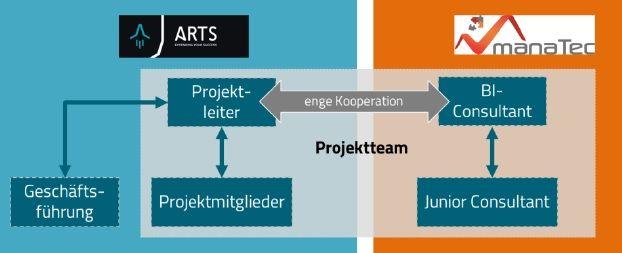
Um einen möglichst stetigen Projektfortschritt gewährleisten zu können, entschied man sich für eine Scrum-ähnliche Vorgehensweise hinsichtlich des Projektmanagements. Dabei wurden in einem regelmäßigen Jour fixe aktuelle Entwicklungsfortschritte diskutiert und neue Ziele festgelegt. Die Weiterentwicklung erfolgte agil in kurzen Projektsprints in enger Kooperation zwischen ARTS und der manaTec GmbH. Alle Entwicklungsfortschritte wurden in einem selbst erstellten BI-Manual festgehalten, um den Know-How-Transfer zwischen den Anwendern sicherzustellen. Strategische Entwicklungsziele wurden in einem Lenkungsausschuss mit der Geschäftsführung ausgearbeitet und priorisiert.
Lesson learned: Agile Entwicklung sichert Ihren Projekterfolg
Business Intelligence ist im innovativen Mittelstand angekommen. Am Anfang einer erfolgreichen und möglichst effizienten Implementierung steht dabei eine durchdachte Konzeption. Eine der größten Gefahren liegt darin, Business Intelligence für einen allgemeinen Anwendungszweck zu implementieren. Ohne einen konkreten Anwendungsfall und die Definition von individuellen Systemanforderungen läuft die Implementierung schnell ins Leere. Definieren Sie deshalb unbedingt vor der Implementierung konkrete Szenarien und Anwendungsfälle.
Ein weiterer Knackpunkt: Business Intelligence lässt sich nicht "on the fly" implementieren. Planen Sie ausreichend Zeit für die anfängliche Erstimplementierung, Weiterentwicklung und Schulung der entsprechenden Nutzergruppen ein. Idealerweise legen Sie bei der Erstimplementierung Meilensteine im Projektplan fest und gestalten die Weiterentwicklung des Systems agil, um auf Veränderungen innerhalb des Unternehmens und neue Anforderungen flexibel reagieren zu können. Dieser Punkt ist wichtig, denn ein fehlendes Change Management innerhalb des Projektes kann sich schnell zu einem Showstopper entwickeln. Definieren Sie für wandelnde und neue Anforderungen klare Vorgaben und Ziele (schlankes Projektmanagement: Wer macht was bis wann?), um Projektverzögerungen vorzubeugen. Oft wird auch erst während der Implementierung deutlich, dass die bisherige Systemlandschaft unzureichend dokumentiert ist.
Die Abstimmung und Integration der Vorsysteme kann sich dadurch schwieriger darstellen, als ursprünglich angenommen. Achten Sie auch hier auf eine schriftliche Dokumentation der aufgebauten Lösungen des BI-Systems, um den Wissenstransfer zwischen den Mitarbeitern zu optimieren. Insbesondere der Mittelstand profitiert dabei von einer vergleichsweise hohen Homogenität der Vorsysteme. Ein oft unterschätzter Punkt ist die Datenqualität. Sorgen Sie von Anfang an für ein effizientes Stammdaten-Management aus den Vorsystemen, um die Präsentation fehlerbehafteter Auswertungen zu vermeiden. Gleichzeitig ist es wichtig, die mit dem BI-Tool gewonnen Erkenntnisse an Maßnahmen zu knüpfen, um maximalen Nutzen aus dem Einsatz der Software zu ziehen.
Um einen gewinnbringenden Einsatz der BI-Software im Unternehmen garantieren zu können, ist eine hohe Akzeptanz der Auswertungen im Unternehmen Grundvoraussetzungen. Achten Sie deshalb bei der Implementierung Ihrer BI-Lösung insbesondere auf:
- Detaillierte Definition der Anforderungen und Anwendungsgebiete (Lastenheft)
- Ausreichenden Zeithorizont für die Erstimplementierung und Anwenderschulungen
- Möglichst detaillierte Dokumentation der Entwicklungsergebnisse
- Permanentes Change Management während der Entwicklungssprints
- Effizientes Stammdaten-Management
Sie planen die Einführung einer Business Intelligence Lösung in Ihrem Unternehmen? Dann kontaktieren Sie uns jetzt und wir beraten Sie sehr gern!
Business Intelligence mit Jedox